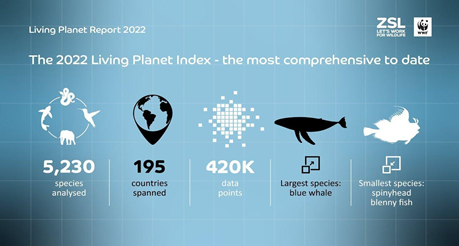

14th October 2022 (10 Topics)
Context
-
-
The Living Planet Report:
- Living Planet Report is WWF’s flagship publication. It is released every two years.
- Objective: It is a comprehensive study of trends in global biodiversity and the health of the planet. It tracks changes in the relative abundance of wild species populations across the globe.
- Changes from the last Report:
- The Living Planet Index (LPI) is continually changing with 838 new species. 11,011 new populations were added to the dataset. Since the 2020 LPR was released.
The Living Planet Index (LPI) is a measure of the state of the world's biological diversity based on population trends of vertebrate species from terrestrial, freshwater, and marine habitats.
The LPI was adopted by the Convention of Biological Diversity (CBD) as an indicator of progress toward its 2011-2020 targets.- There has been a significant increase in the number of fish species (481). That has been added to the Living Planet Report.
Key highlights: (Addressing Environment & Biodiversity)
The decline in Population:
- There has been a 69 percent decline in the wildlife populations of mammals, birds, amphibians, reptiles, and fish, across the globe in the last 50 years.
- The freshwater populations have declined the most, with an average 83% decline between 1970 and 2018.
- The IUCN Red List shows cycads, an ancient group of seed plants, are the most threatened species. While corals are declining the fastest, followed by amphibians.
Region-wise assessment:
- The highest decline (94 percent) was in Latin America and the Caribbean region.
- Africa recorded a 66 percent fall in its wildlife populations from 1970-2018.
- Asia Pacific’s monitored populations fell by 55%.
- Southeast Asia is the region, where species are most likely to face threats at a significant level.
- The Polar Regions and the east coast of Australia and South Africa showed the highest impact probabilities for climate change, driven in particular by the impact on birds.
Mangroves:
- Mangroves continue to be lost to aquaculture, agriculture, and coastal development at a rate of 13 percent per year.
- Mangrove loss represents the loss of habitat for biodiversity and the loss of ecosystem services for coastal communities.
- Around 137 square kilometers of the Sundarbans mangrove forest in India and Bangladesh have been eroded. Since 1985, reducing land and ecosystem services for many of the 10 million people who live there.
Corals:
- About 50% of warm water corals have already been lost. Warming of 1.5 degrees Celsius will lead to a loss of 70-90% of warm water corals.
- The Bramble Cay melomys, a small Australian rodent, was declared extinct after the sea-level rise.
Sharks:
- The global abundance of 18 of 31 oceanic sharks has declined by 71% over the last 50 years. The report said that by 2020 three-quarters of sharks and rays were threatened with extinction.
Others:
- Only 37% of rivers longer than 1,000km remain free-flowing over their entire length.
- 41% of land-use change is the biggest current threat to nature.
- The report says action is needed to reverse biodiversity loss by 2030 and keep global warming to 1.5ºC.
- By moving to sustainable, healthy, and culturally appropriate diets. We can reduce agricultural land use by 41% and wildlife loss by up to 46%.

-
Report highlights for India:
- Vulnerability of Biospheres: The Himalayan region and the Western Ghats are some of the most vulnerable regions in the country in terms of biodiversity loss. Where increased biodiversity loss is expected in the future if temperatures are to increase.
- Indicators of Ecosystem health are in Danger: India has seen a decline in the population of the likes of honeybees. 17 species of freshwater turtles in this period.
Anthropogenic causes:
- Habitat loss and barriers to migration routes
- Land-use change is still the biggest current threat to nature
- Human-induced climate change and biodiversity losses
- Agriculture is the most prevalent threat to amphibians
Threats:
- WWF identified six key threats to biodiversity: agriculture, hunting, logging, pollution, invasive species, and climate change to highlight ‘threat hotspots' for terrestrial vertebrates.
- Climate change in India will impact key areas, such as water resources, agriculture, natural ecosystems, health, and the food chain.


